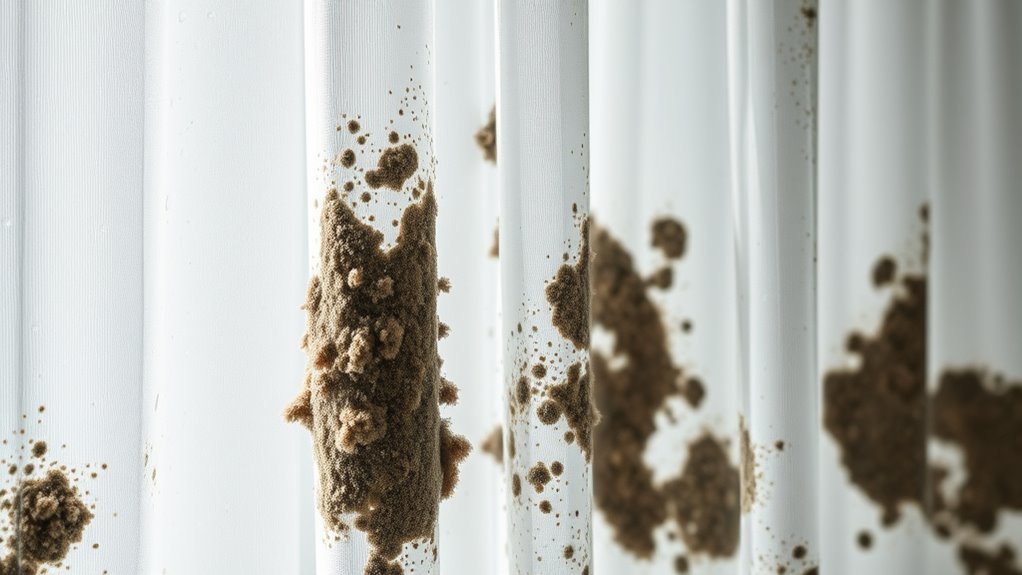To stop mold on your shower curtain for good, clean it regularly with a vinegar and baking soda solution, and make certain you dry it thoroughly after each use. Improve ventilation by using an exhaust fan or opening a window, and keep the curtain spread out to dry completely. Consider replacing plastic curtains with mold-resistant or quick-drying options. With consistent cleaning and proper airflow, you’ll keep mold at bay—learn more tips to keep your bathroom spotless.
Key Takeaways
- Regularly clean your shower curtain with vinegar or mold-killing detergent to prevent mold buildup.
- Ensure proper bathroom ventilation by using exhaust fans or opening windows during and after showers.
- Dry the curtain thoroughly after each use to reduce moisture and inhibit mold growth.
- Replace plastic curtains periodically and consider mold-resistant or quick-drying fabric options.
- Maintain routine cleaning and good ventilation to keep your bathroom mold-free long-term.

Mold on your shower curtain is a common problem that can affect your home’s cleanliness and your health. It can develop quickly in the humid environment of your bathroom, especially if you don’t take steps to prevent it. When you notice dark spots or fuzzy patches on your curtain, it’s tempting to ignore them, but mold can cause allergic reactions, respiratory issues, and even infections over time. Addressing the problem promptly is essential to keep your bathroom safe and hygienic.
Mold on shower curtains can harm your health—act quickly to keep your bathroom safe and clean.
The first thing you should do is understand how mold takes hold. Mold spores are everywhere, floating in the air and settling on damp surfaces. Your shower curtain provides an ideal breeding ground—warm, moist, and often rarely dried thoroughly. When you shower, water collects on the curtain, and if it stays damp, mold spores find a perfect environment to grow. Poor ventilation, infrequent cleaning, and using plastic curtains that trap moisture only exacerbate the issue.
To stop mold from spreading on your shower curtain, start by regularly cleaning it. You can remove mold with a simple solution of water and white vinegar, which is both effective and eco-friendly. Spray or wipe the curtain with this mixture, paying particular attention to areas with visible mold. For stubborn spots, applying a paste of baking soda and water can help scrub away mold without damaging the fabric or plastic. Make sure to rinse thoroughly and dry the curtain as much as possible after cleaning.
Another essential step is to keep your bathroom well-ventilated. Use an exhaust fan during and after showers to reduce humidity levels, or open a window if possible. This helps moisture evaporate quickly, preventing mold from settling in. When you’re done showering, spread the curtain out to allow it to dry thoroughly. Avoid leaving it bunched up or hanging in a damp state, as this creates the perfect environment for mold to thrive.
Replacing your shower curtain periodically is also a smart move. Plastic curtains tend to accumulate mold over time, even with regular cleaning. Consider switching to mold-resistant curtains or fabric options that dry faster and are less prone to mold growth. Additionally, washing your curtain weekly with hot water and bleach or a mold-killing detergent can keep mold at bay and extend its lifespan. Regular ventilation and maintenance are key to preventing future mold issues and maintaining a healthy bathroom environment.
Frequently Asked Questions
Can Mold on Shower Curtains Cause Health Issues?
Yes, mold on shower curtains can cause health issues. Mold releases spores and mycotoxins that you might breathe in, leading to respiratory problems, allergies, or asthma flare-ups. If you notice mold, it’s important to clean or replace your curtain promptly. Regular ventilation and wiping down the curtain after each shower can help prevent mold growth, protecting your health and keeping your bathroom fresh.
Are There Eco-Friendly Ways to Prevent Mold Growth?
You can prevent mold growth with eco-friendly methods. Think of your shower curtain like a garden—if you don’t water it properly, weeds take over. Keep your bathroom ventilated, wipe down the curtain after showers, and use natural antifungal solutions like vinegar or tea tree oil. These eco-friendly options deter mold without harsh chemicals, helping your bathroom stay fresh and healthy while safeguarding the environment.
How Often Should I Replace My Shower Curtain?
You should replace your shower curtain every six months to a year, especially if you notice mold, mildew, or persistent stains. Regular replacement helps prevent mold buildup and keeps your bathroom hygienic. In addition, clean your curtain weekly with mold-resistant spray or vinegar to extend its lifespan. If the curtain shows signs of wear or mold that won’t wash away, it’s best to replace it sooner for a healthier, fresher shower environment.
Do Certain Materials Resist Mold Better Than Others?
Yes, some materials resist mold better than others. Vinyl and polyester curtains are less prone to mold since they dry quickly and don’t absorb moisture. Fabric curtains, especially those made from cotton or linen, tend to harbor mold more easily because they absorb water and take longer to dry. To prevent mold, choose water-resistant materials, keep your curtain well-ventilated, and wash it regularly.
Can I Remove Mold From Fabric Shower Curtains Effectively?
A stitch in time saves nine, so addressing mold early is key. You can effectively remove mold from fabric shower curtains by mixing equal parts white vinegar and water, then scrubbing the affected areas with a soft brush. For stubborn spots, use a mixture of baking soda and water or a gentle bleach solution. Always air dry thoroughly afterward, as prevention beats cure. Regular cleaning keeps mold at bay and extends your curtain’s life.
Conclusion
Don’t let mold take over your shower curtain again. With regular cleaning and proper ventilation, you can keep it fresh and mold-free. Remember, a quick wipe after each shower and keeping the bathroom dry makes all the difference. Isn’t it worth enjoying a clean, mold-free space every day? Take action now—your bathroom deserves it, and so do you. Say goodbye to mold and hello to a healthier, cleaner shower experience!









